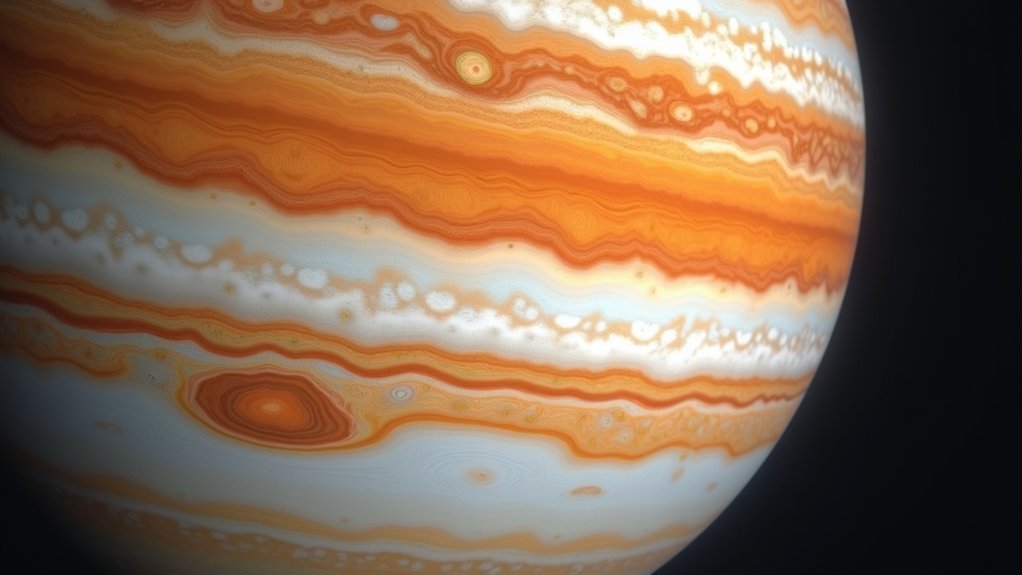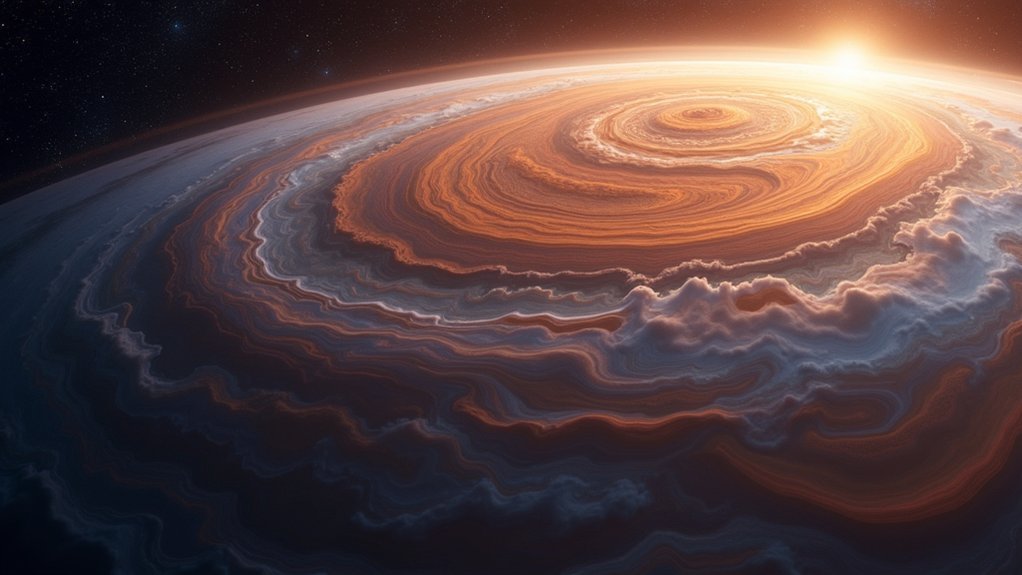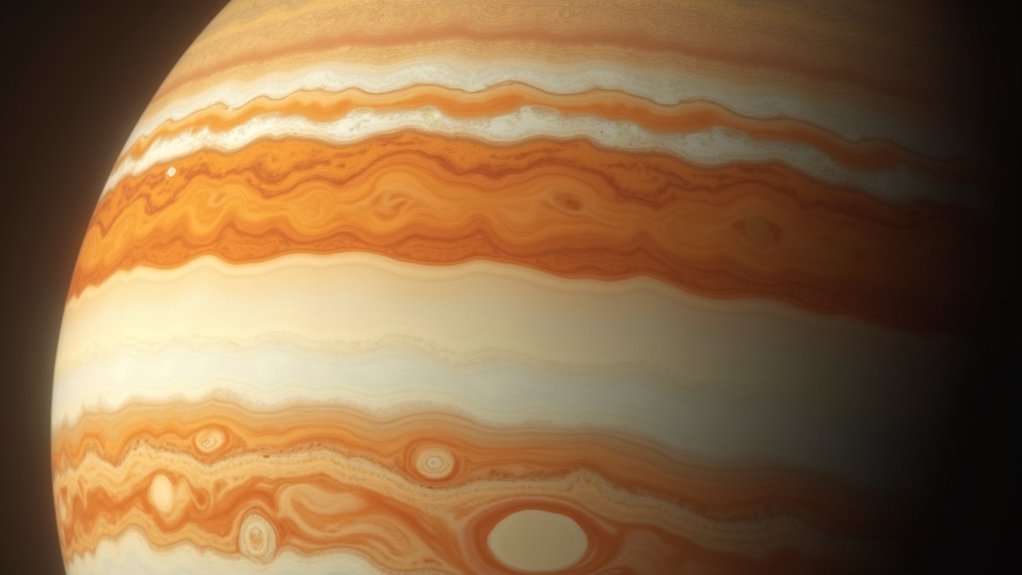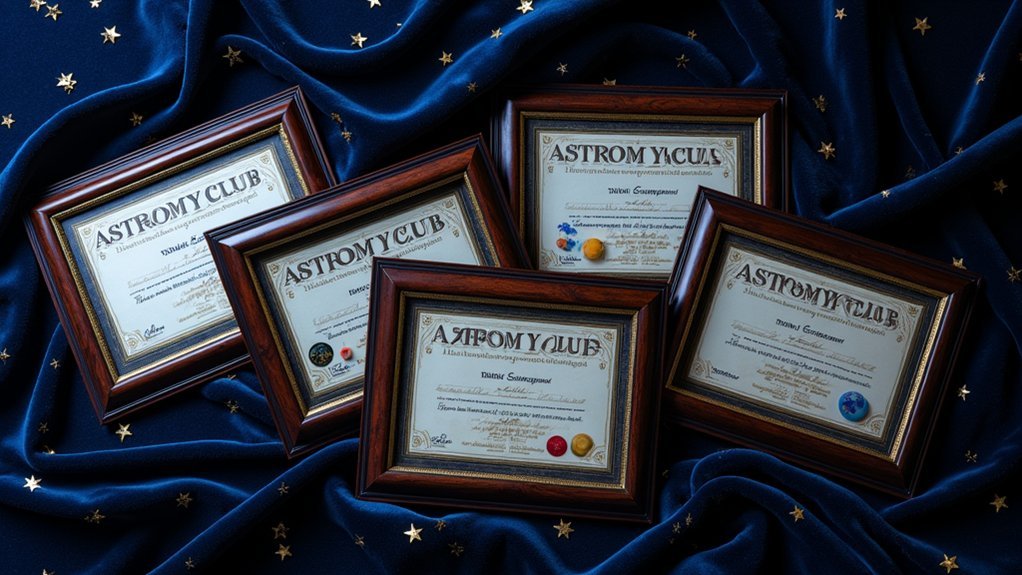Jupiter’s cloud bands change colors due to a fascinating combination of atmospheric chemistry and magnetic forces. You’re seeing the effects of ammonia and hydrogen sulfide interacting while being influenced by Jupiter’s powerful magnetic field. These interactions create the distinctive reddish-orange and cream-colored stripes that transform every four to five years. Recent NASA Juno mission data reveals that magnetic oscillations directly affect these color variations, creating the dynamic patterns you observe. The connection between Jupiter’s magnetic heart and its colorful exterior tells an even deeper story.
The Colorful Bands of Jupiter: What You’re Actually Seeing

When you gaze at Jupiter through a telescope, you’re witnessing one of the solar system’s most spectacular atmospheric displays.
Those vibrant bands aren’t just for show—they’re dynamic systems of clouds containing ammonia and hydrogen sulfide that create their distinctive colors.
What you’re seeing is a complex dance of eastward and westward winds forming dark and light belts that continuously reshape Jupiter’s atmosphere.
Every four to five years, these bands undergo dramatic color changes due to shifting atmospheric dynamics and convection patterns.
The towering Great Red Spot sits higher than surrounding clouds, adding to the visual drama.
Rising majestically above Jupiter’s swirling cloud layers, the iconic Great Red Spot creates a captivating focal point in the planetary panorama.
Scientists have even discovered that infrared radiation variations, connected to oscillations in Jupiter’s magnetic field, influence how these majestic bands appear and change over time.
Atmospheric Chemistry Behind Jupiter’s Changing Stripes
Although Jupiter appears simply striped from a distance, the chemistry behind these bands reveals extraordinary complexity.
Jupiter’s atmosphere contains ammonia and water clouds that interact with other compounds to create the planet’s distinctive coloration. When you observe color variations in these cloud bands, you’re witnessing the results of chemical processes influenced by both internal heating and changing insolation.
The reddish and orange hues you see develop when ammonium hydrogen sulfide alters how light reflects from the atmosphere. These colors aren’t static—the dynamic nature of Jupiter’s weather systems continuously generates and destroys colorful compounds.
Pressure differences throughout atmospheric layers further affect how these chemicals manifest visually. Impurities within the gases introduce additional complexity, explaining why Jupiter’s stripes appear to change over time rather than remaining constant.
Jupiter’s Magnetic Field: The Hidden Influence on Cloud Colors

You’ll be surprised to learn that Jupiter’s cloud colors are influenced by torsional waves in its magnetic field, as revealed by NASA’s Juno spacecraft.
These magnetic oscillations match the cycles of color variation in Jupiter’s iconic stripes, establishing a direct link between the planet’s interior and its visible appearance.
This connection offers scientists a window into Jupiter’s deep structure, similar to how seismology helps us understand Earth’s interior.
Torsional Waves Revealed
While Jupiter’s striking cloud bands have captivated astronomers for centuries, recent discoveries suggest these colorful features may be influenced by invisible forces deep within the gas giant.
NASA’s Juno spacecraft has detected torsional oscillations in Jupiter’s magnetic field that seemingly correspond with changes in cloud colors. Dr. Kumiko Hori and Professor Chris Jones’s groundbreaking research reveals these magnetic oscillations match periods of infrared variations detected 50 kilometers beneath Jupiter’s surface.
The Great Blue Spot‘s observed slowdown provides further evidence of this oscillatory behavior.
These findings point to a fascinating connection: Jupiter’s magnetic dynamics may directly drive atmospheric changes that manifest as the colorful bands you’ve observed through telescopes.
As scientists continue analyzing Juno’s data, they’re uncovering how these torsional waves propagate through the planet, potentially solving the long-standing mystery of Jupiter’s ever-changing appearance.
Deep Interior Connection
Beneath Jupiter’s mesmerizing cloud bands lies a powerful driver of atmospheric change: its massive magnetic field.
You’re witnessing a complex dance between Jupiter’s deep interior and its visible atmosphere, where torsional oscillations in the magnetic field directly influence cloud bands approximately 50 kilometers below the surface.
These oscillations correlate precisely with variations in infrared radiation, creating the color changes you observe every four to five years.
The Juno spacecraft has been instrumental in revealing these connections since 2016, capturing data that shows how the magnetic field’s fluctuations ripple through Jupiter’s weather systems.
Scientists now approach Jupiter’s atmospheric dynamics similar to Earth’s seismology, using these magnetic interactions to understand how the gas giant’s deep interior orchestrates the spectacular color shifts in its atmospheric bands.
Seasonal Patterns and Cyclical Color Changes in Gas Giants
You’ll notice Jupiter’s cloud bands transform through magnetic field oscillations that occur every four to five years, creating visible torsional effects on its atmospheric patterns.
These oscillations directly affect how chemicals in the ammonia and water clouds interact, producing the shifting colors you can observe through telescopes.
The periodic nature of these changes mirrors seasonal patterns, though Jupiter’s “seasons” result from complex atmospheric dynamics rather than axial tilt alone.
Magnetic Field Oscillations
Although invisible to the naked eye, Jupiter’s powerful magnetic field plays an essential role in orchestrating the planet’s distinctive color changes.
Recent research reveals that torsional oscillations within Jupiter’s magnetic field directly correlate with the four-to-five-year cycle of cloud band transformations.
You’ll find the evidence in NASA’s Juno spacecraft data, which shows that these oscillations match perfectly with periodic variations in infrared radiation detected in Jupiter’s deep interior.
The Great Blue Spot, a prominent magnetic feature, undergoes significant changes that align with these cycles.
As the magnetic field oscillates, it influences atmospheric dynamics and triggers the visible color shifts in Jupiter’s clouds.
This connection between the planet’s magnetic pulsations and atmospheric appearance helps scientists unravel the complex interplay between internal forces and external manifestations in gas giants.
Chemical Composition Shifts
While Jupiter’s magnetic field influences its cloud bands, the stunning color variations we observe primarily stem from cyclical shifts in atmospheric chemical composition. You’ll notice these changes occur every four to five years, as chemicals like ammonia and ammonium hydrogen sulfide interact differently within Jupiter’s clouds.
| Chemical Factor | Emotional Impact |
|---|---|
| Ammonia shifts | Wonder at the sudden white zones |
| Thermal dynamics | Awe as heat creates color contrasts |
| Gas condensation | Surprise at emerging orange swirls |
| Atmospheric convection | Fascination with evolving patterns |
| Pressure variations | Excitement during dramatic darkening |
The interplay between Jupiter’s internal heat and solar radiation drives these processes, creating pressure differences that affect cloud formation. These atmospheric dynamics continuously reshape the planet’s appearance as convection currents transport chemicals between layers, producing the mesmerizing color shifts you see through telescopes.
How to Observe Jupiter’s Band Transformations With Amateur Telescopes

Even with modest equipment, amateur astronomers can witness the dramatic color shifts and structural changes in Jupiter’s cloud bands.
The breathtaking dance of Jupiter’s cloud formations remains accessible to stargazers with even basic telescopic setups.
You’ll need a telescope with at least 4 inches of aperture to capture the intricate details of these colorful features.
- Choose ideal conditions – Look for nights with minimal atmospheric turbulence for the best visibility of orange, red, and white bands
- Apply color filters – Use blue or red filters to enhance contrast and highlight specific cloud bands
- Monitor consistently – Track Jupiter over several months to document band changes that occur every four to five years
- Locate accurately – Utilize tracking software or star charts to find Jupiter’s position, which changes frequently as it orbits the Sun
Recent Discoveries From Nasa’s Juno Mission About Band Coloration
Since its arrival at Jupiter in 2016, NASA’s Juno mission has revolutionized our understanding of the gas giant’s colorful cloud bands. Research by Dr. Hori and Dr. Jones revealed a fascinating connection: torsional oscillations in Jupiter’s magnetic field directly correlate with the color changes observed in the planet’s distinctive bands every four to five years.
| Discovery | Implication | Future Research |
|---|---|---|
| Magnetic field-cloud correlation | Magnetic forces influence band coloration | Deeper atmospheric modeling |
| Infrared variations 50km below surface | Internal processes drive visible changes | Extended Juno mission data |
| Great Blue Spot slowing | Possible oscillation affecting band colors | Tracking magnetic field evolution |
You’re witnessing science unfolding in real time as researchers work to understand the complex interplay between Jupiter’s magnetic field and atmospheric dynamics that create the stunning visual patterns we observe.
Frequently Asked Questions
What Causes Jupiter’s Bands to Display Different Colors?
You’ll see Jupiter’s bands change colors due to variations in atmospheric chemistry, temperature changes, and strong wind patterns. These factors interact with ammonia and water clouds, creating the distinctive color shifts you observe.
What Do the Different Colors in Jupiter’s Clouds Indicate?
When you’re looking at Jupiter’s clouds, you’re seeing various chemical compositions. The different colors indicate ammonia and hydrogen sulfide concentrations, altitude variations, thermal differences, and pressure changes throughout the planet’s dynamic atmosphere.
Why Does Jupiter Change Colours?
Jupiter’s colors change because you’re seeing chemical reactions in its atmosphere. Sunlight, heat, and magnetic oscillations alter compounds like ammonia, while torsional field movements affect the radiation patterns. It’s a constantly evolving chemical display.
What Causes the Dark and Light Colored Bands of Jupiter?
Jupiter’s dark and light bands result from you seeing alternating wind patterns that create zones and belts. You’ll notice different chemicals in these layers scatter light differently, with ammonia-rich zones appearing lighter than chemical-rich belts.
In Summary
You’re witnessing a dynamic atmosphere when Jupiter’s bands change colors. These shifts result from complex interactions between atmospheric gases, magnetic fields, and seasonal temperature variations. Chemical reactions transform compounds, while storms mix materials between layers. As you observe these transformations through your telescope, you’re seeing weather patterns on a massive scale—processes that Juno’s mission continues to help us understand better every day.





Leave a Reply